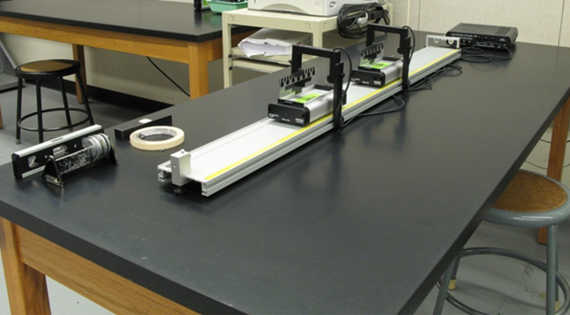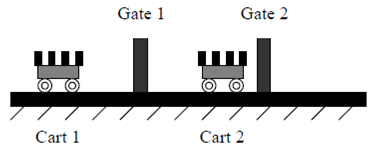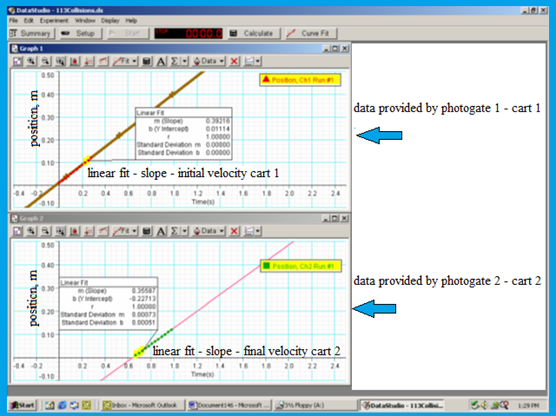Conservation of Momentum and Energy
Objectives
-
•to investigate simple elastic and inelastic collisions in one dimension to study the conservation of momentum and energy phenomena
Equipment
- horizontal dynamics track
- collision and dynamics carts with picket fences
- photogates connected to the Science Workshop interface

Figure 1
Introduction and Theory
Collisions are an important way of studying how objects interact. Conservation laws have been developed that allow one to say quite a bit about what is happening without knowing the exact details of the interaction during the collision. In this lab, you will show that the total momentum of the system is always conserved when there is no net external force acting on the system, and that the total mechanical energy of the system is only conserved in certain kinds of collisions. These principles are important in studying automobile collisions, planetary motion, and the collisions of subatomic particles. Momentum is the product of mass (m) and velocity (v), so it has the units of kg · m/sec. Momentum is a vector quantity with its direction the same as the velocity. We do not have a special name for the unit of momentum, but we do commonly use the letter p to represent the momentum vector.( 1 )
p = m · v( 2 )
Σpi = Σpf.
( 3 )
m1v1ix + m2v2ix = m1v1fx + m2v2fx.
( 4 )
| 1 |
| 2 |
| 1 |
| 2 |
| 1 |
| 2 |
| 1 |
| 2 |
Procedure
Please print the worksheet for this lab. You will need this sheet to record your data. The experimental setup is depicted in fig.1 and 2. The two photogates will record the position of carts as a function of time. This is done by using picket fences of known band spacing.
Figure 2
1
Make sure that the photogate light beam is level with the 1 cm-spaced bands. Open the pre-set experiment file: Labs/PHY 113/PreSetUp Labs/Conservation of Momentum. The recording has to be started and stopped manually.
2
The carts used in this activity have two kinds of ends. One set of ends allows the carts to stick together (interlocking velcro tape), while the other set of ends, equipped with strong magnets, causes the carts to repel each other.
Before performing the lab, you need to check if the frictionless track is leveled.
The space between the photogates should be wide enough that the first cart collides with the second cart after it completely passes the first photogate. Before each collision, place the second cart right in front of the second photogate. The first cart has to be launched from left to right in the positive x-axis direction.
3
To achieve the objective of this lab, you have to analyze the following four cases (two inelastic collisions and two elastic collisions).
-
AInelastic collision (carts stick together after the collision), where
-
•m1 = m2
-
•v2i = 0
-
-
BInelastic collision (carts stick together after the collision), where
-
•m1 ≠ m2
-
•v2i = 0
-
-
CElastic collision (carts stay separated after the collision), where
-
•m1 = m2
-
•v2i = 0
-
•The first cart is expected to come to a complete stop after the collision.
-
-
DElastic collision (carts stay separated after the collision), where
-
•m1 < m2
-
•v2i = 0
-
•To significantly change the mass of the cart, add the heavy metal block.
-
•The first cart is expected to bounce off with a reduced velocity. Be sure to measure and record the velocity of the first cart after the collision, too.
-
4
To test if the Law of Conservation of Momentum and the Law of Conservation of Energy hold true in the collisions of the carts, you need to record the mass of each cart, as well as the initial and final velocity of each cart before and after collision. The two graphs provide the data for each cart.

Figure 3: A sample of the experiment file in DataStudio®
5
Because the track and the carts are not totally frictionless, it is recommended to fit only a small part of the recorded position closest at the instant of collision. Tabulate the initial velocity of each cart before collisions, and final velocity of each cart after the collision. Note that when the carts stick together and move together after the collision, the velocity of both carts is the same.
6
Based on recorded data, calculate the momentum of each cart before and after collision. Then, calculate the total momentum of both carts before and after collision. Calculate the percent discrepancy between initial and final momentum of the system. What percent of the momentum has been lost due to friction?
7
To check if the energy is conserved, calculate the initial and final kinetic energy for each cart. Then, calculate the kinetic energy for both carts before and after the collision. Calculate the percent discrepancy between initial and final energy of the system. In what type of collision is the higher percent of energy lost?
8
Upload the file with your graphs. Do a print screen and save the graphs as a file with a maximum size of 1 MB. (You will upload this file in the WebAssign question.) Print the graph for your TA to sign, and for your reference.

